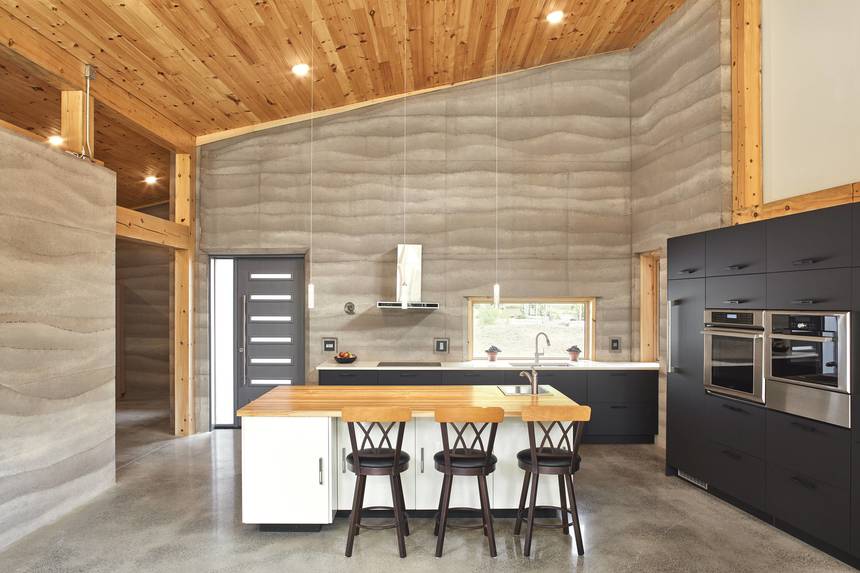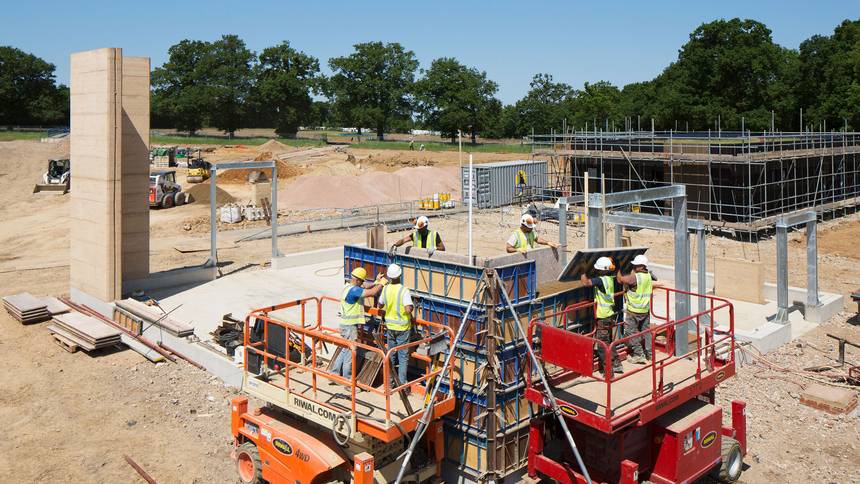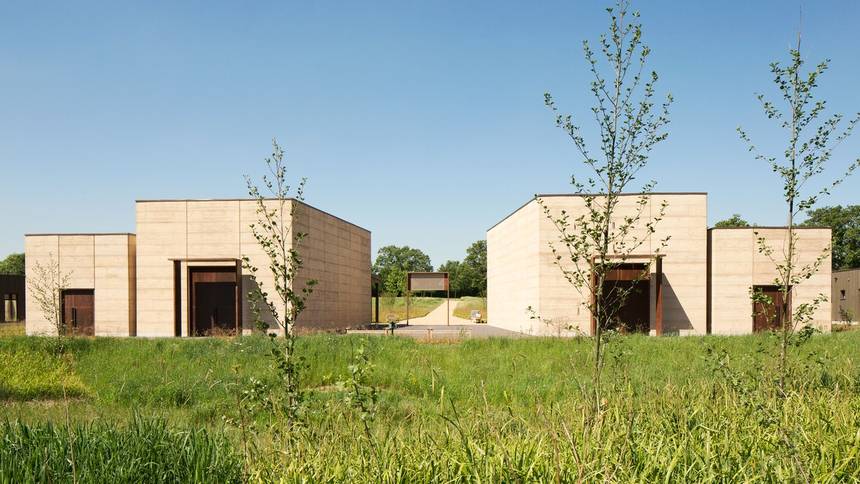Rammed earth is made of damp soil or earth that is placed in formwork, and then compressed or rammed into a solid, dense wall. As a construction technique, rammed earth has been eclipsed by the development of reinforced concrete, but there has been renewed interest because of its aesthetics and its perceived environmental benefits.
The carefully chosen mix of silt, sand, gravel and clay is moistened and then placed in about 4 inch deep layers between wood or metal forms; that’s why one sees the different colors and stripes, as often each layer is modified for aesthetic reasons. It used to be rammed by hand, but now powered rams are often used to reduce time and labor. Engineered structural reinforcing is often required.
Rammed earth expert Chris Magwood of the Endeavour Centre says the formwork is critical.
Formwork is the key to building with rammed earth, and the better the formwork the faster and more accurate the construction. Forms must be able to withstand the considerable forces of ramming the earth within and be able to be assembled and disassembled with a minimum of effort. Formwork that is reusable can help keep costs down.
Electric wiring and switch boxes can be built right into the wall as it goes up, so that a clean, interior earth finish can be maintained.
There are two main kinds of rammed earth: Raw, which is carefully mixed earthen materials and stabilized, where some kind of binder, usually cement, is added to hold it together. Many architects prefer working with raw rammed earth. Architect Martin Rauch says:
Interfering in the material properties of loam is detrimental. One thus takes away its most important characteristic, since the material can only be integrated into the cycle of materials again without admixtures. When being dismantled, the wall once again becomes the earth from which it came.
Others, like engineer Tim Krahn, agree in principle but write that “the physical and regulatory climates in North America make it difficult to build code-conforming, durable raw earth structures.” He notes that the freeze-thaw cycles in the northern United States and Canada make the durability of raw earth walls dubious.
The manufacture of cement is responsible for as much as seven percent of the CO2 produced each year, and standard concrete is between 10 and 15 percent cement, the rest being sand and aggregate. So when cement is added to rammed earth, Krahn notes that “detractors may argue that this means we are effectively creating nothing more than damp-pack concrete.”
Indeed, some have argued that adding cement is essentially greenwashing. Critic Phineas Harper says:
Architects may specify this material in part to project a facade of environmental stewardship onto the walls of their building, when under the surface all is not as it seems. Compacted soil is a beautiful material, its striations echoing the strata of the Earth’s crust, but depending on how you use it, it can harm, as well as evoke, the planet. There is no need to build rammed earth with cement… Some designers, however, are choosing the humble aesthetic of earth, and its ecological connotations, but without the sincerity to follow through those values on the construction site.
Stabilized walls do have less cement than concrete walls (between 5 and 8 percent), and there are also alternative binders, known as pozzolans like lime, that can be used, along with blast-furnace slag or coal ash. This dramatically lowers the embodied carbon. Also, unlike concrete where sand and aggregate is often hauled great distances, the soil used in rammed earth building can be far more local.
The consensus, even among builders of stabilized walls, is that raw walls are “greener”, but that stabilized walls aren’t “greenwashing” because they still have about half the carbon footprint of concrete walls.
Other Benefits of Rammed Earth
- As critic Harper noted, they can be beautiful. Designers and builders can change the mix of dirt and soils to get a wide range of colors, and changes in the formwork can add textures.
- The walls have tremendous thermal mass, which is useful in places with a big diurnal swing in temperature between day and night; that’s why adobe is so popular in the south.
- The material cost is literally dirt cheap. Most of the cost is in labor, which can be mostly unskilled if well supervised.
- Being all-natural, there is no out-gassing of volatile organic compounds, no red-listed ingredients, so it is considered a healthy building material.
- The thick walls have excellent acoustic properties, keeping noise out while also having good sound reverberation characteristics.
Problems with rammed earth
- You are not ordering it from the supplier like concrete; it is mixed on site and must have a proper mix of clays and sands, packed and rammed to the proper density. So someone with experience is needed.
- Really careful design is required to keep water away from the walls, although this depends on the amount of stabilization. Raw wall architect Martin Rauch actually puts horizontal stone drip ledges into his raw rammed earth to keep water from running down the walls and eating them away.
- Rammed earth may have thermal mass, but it is a poor insulator. Tim Krahn calls this “rammed earth’s dirty secret”, that it is often insulated with plastic foams which have very high embodied carbon. “I find this truth hard to swallow, but it is truth nonetheless.” However, there are now wood fiber and even mushroom insulations with far smaller footprints than foam. This is really no different than any other wall, any other form of construction.
So what’s the real dirt on rammed earth?
There’s lots to love about rammed earth; it can be beautiful to look at, there’s not much waste, material costs are low, material availability is easy, and indoor air quality is excellent.
On the downside, the labor costs can be very high, the energy efficiency of the rammed earth on its own is very low, and the skill level needed by at least someone on site is very high.
And of course, the elephant in the room is the stabilizing binder. If it’s Portland cement and it’s higher than 10 percent, then the stuff really is little more than damp-pack concrete. When we are trying to live in a 1.5 degree world, then it is really just a little bit less bad.
You can read the original article at www.treehugger.com

I want to add another element to rammed earth…a coating
Please let me know who to talk to
Coatings can be quite technical and need a proper analysis, please refer to my website, http://www.rammedearth.info This is a consulting type of thing, I have an expert that I bring into the equation.
Clifton Schooley